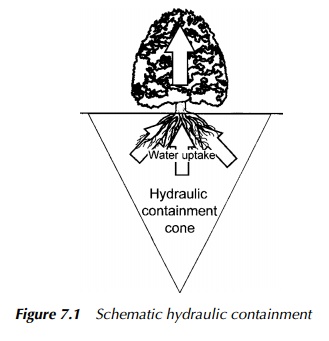Chapter: Environmental Biotechnology: Phytotechnology and Photosynthesis
Hydraulic Containment
Hydraulic Containment
Large plants can act as living pumps, pulling large amounts of
water out of the ground which can be a useful property for some environmental
applications, since the drawing of water upwards through the soil into the
roots and out through the plant decreases the movement of soluble contaminants
downwards, deeper into the site and into the groundwater. Trees are
particularly useful in this respect because of their enormous transpiration
pull and large root mass. Poplars, for example, once established, have very
deep tap roots and they take up large quanti-ties of water, transpiring between
200 – 1100 litres daily. In situations where grass-land would normally support
a water table at around 1.5 metres, this action can lead to it being up to 10
times lower. The aim of applying this to a contamination scenario is to create
a functional water table depression, to which pollutants will tend to be drawn
and from which they may additionally be taken up for treatment. This use of the
water uptake characteristics of plants to control the migration of

Buffer strips are intended
to prevent the entry of contaminants into water-courses and are typically used
along the banks of rivers, when they are sometimes called by the alternative
name of ‘riparian corridors’, or around the perimeter of affected sites to
contain migrating chemicals. Various poplar and willow varieties, for example,
have shown themselves particularly effective in reducing the wash-out of
nitrates and phosphates making them useful as pollution control measures to
avoid agricultural fertiliser residues contaminating waterways. Part of the
potential of this approach is that it also allows for the simultaneous
integration of other of the phytoremediating processes described into a natural
treatment train, since as previously stated, all plant-based treatments are
aspects of the same fundamental processes and thus part of a cohesive whole.
Another approach sometimes
encountered is the production of vegetative caps, which has found favour as a
means of finishing off some American landfill sites. The principle involves
planting to preventing the downward percolation of rain-water into the landfill
and thus minimising leachate production while at the same time reducing erosion
from the surface. The method seems to be successful as a living alternative to
an impermeable clay or geopolymer barrier. The vegetative cap has also been
promoted for its abilities to enhance the biological breakdown of the
underlying refuse. In this respect, it may be seen as an applied form of
rhi-zodegradation or even, arguably, of phytodegradation. How effective it is
likely to be in this role, however, given the great depths involved in most
landfills and the functionally anoxic conditions within them, appears
uncertain.
To understand the overall
phytoremediation effect of hydraulic containment, it is important to realise
that contaminating organics are actually taken up by the plant at lower
concentration than they are found in situ, in part due to membrane barriers at
the root hairs. In order to include this in a predictive mathematical model,
the idea of a transpiration stream concentration factor (TSCF) for given
contaminants has been developed, defined as TSCF = 0.75 exp{−[(log Kow − 2.50)2/2.4]},
(Burken and Schnoor 1998) where Kow is the octanol – water par-tition
coefficients. These latter are a measure of the hydrophobia or hydrophilia of a
given organic chemical; a log Kow below 1 characterises the fairly soluble,
while above 3.5 indicates highly hydrophobic substances.
Thus the uptake rate (U in mg/day) is given by the following equation:
U = (TSCF )T C
Where:
TSCF =transpiration stream
concentration factor, as defined
T=transpiration rate of vegetation, l/day
C =concentration in site water, mg/l
However, it must also be remembered in this
context that, should the pollutants not themselves actually be taken up by the
plants, then the effect of establishing a hydraulic containment regime will be
to increase their soil concentration due to transpiro-evaporative
concentration. Thus, the mass of affected water in the contaminant plume
reduces, as does the consequent level of dilution it offers and hence,
increased localised concentration can result.
The transpiration pull of
plants, and particularly tree species, has also some-times been harnessed to
overcome localised water-logging, particularly on land used for agricultural or
amenity purposes. To enhance the effect at the point worst affected, the
planting regime may involve the establishment of close groupings, which then
function as single elevated withdrawal points. The noted ability of poplars to
act as solar-powered hydraulic pumps makes them of great potential benefit to
this kind of phytotechnological application. Although other plant-based
processes could be taking place at the same time to remediate land alongside
this to clean up contaminated soils, this particular technique is not itself a
type of phytoremediation. Instead, it is an example of the broader
bioengineering possibilities which are offered by the appropriate use of flora
species to wider environmental nuisances, which, for some sites, may be the
only economic or practicable solution. This may be of particular relevance to
heavy soils with poor natural interparticulate spacing, since laying adequate
artificial drainage systems can often be expensive to do in the first place and
are frequently prone to collapse once installed.
Another similar example of
the use of phytotechnology to overcome nuisance is the bio-bund, which consists
of densely planted trees, often willows, on an engineered earthwork embankment.
This system has been used successfully to reduce noise pollution from roads,
railways and noisy industrial sites, the inter-locking branches acting as a physical
barrier to deaden the sound as well as having a secondary role in trapping
wind-blown particulates. Depending on the individual site, the bio-bund can be
constructed in such a way that it can also act as a buffer strip to control
migrating chemical pollution, if required.
Related Topics